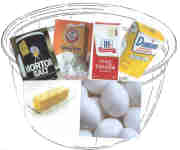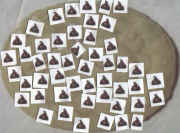As a certified teacher, I’ve learned that while we are trying to teach young children to self govern their behavior, they are highly motivated by extrinsic rewards for positive experiences. Extrinsic rewards help motivate intrinsic motivation in young children when handled appropriately.
An “I’m Amazing!” Sticker Chart
Our sticker charts at home are called “I’m Amazing!” charts. Whenever we see the kids doing something great, we give them a sticker to add to their own chart. We tell them specifically what the behavior was that we liked, and as they put the sticker on they exclaim “I’m AMAZING!” Then we write what they did below the sticker. Inevitably, the kids then review what they did for all their stickers–a great reminder and reinforcement for the positive behavior!
As is everything child-related, communication is key. Specifically tell the children what they did that was so great, and try to acknowledge the intrinsic characteristic more than the action.
“You worked really hard on that picture” instead of “Wow, that’s really pretty.” Pretty or not, the fact that your child sat and focused for so long is an accomplishment to be recognized.
“You were really patient when your brother was bothering you” instead of just “Good job” helps kids sort through and identify the specific good behavior from the bad.
When we do this, we help our children nurture their positive self-image. There is a difference between “You’re so smart!” and “You work really hard to be a good reader!” The child that is convinced he is so smart is crushed when he does poorly on the test. One who believes it is through his hard work is more apt to try harder next time.
But you all know this. And the sticker chart is not an original idea. If you came for a quick idea you can print off and use, here it is:
The Cookie Rewards
This is an idea I’ve used with my own kids and in small classes. I’ve used it for a one-week behavior tool, and for a 7-week behavior tool (like with my Sunday School class I teach, or to reinforce my children’s church behavior). And in each setting, I’ve loved the results. Here’s how it works.
 Every day, the kids are working towards earning an ingredient to make a cookie. The benefit to this is they are working together on a long-term goal, which means less extrinsic rewards — and baking — for you, and more opportunities to praise the good without attaching a tangible reward.
Every day, the kids are working towards earning an ingredient to make a cookie. The benefit to this is they are working together on a long-term goal, which means less extrinsic rewards — and baking — for you, and more opportunities to praise the good without attaching a tangible reward.
 In introducing this plan to the children, I point out that butter, sugar, eggs, baking powder, etc. would make a good cookie, but it would be a boring cookie. Together we agree chocolate chips would make it better. And this is the fun part. Chocolate Chips are earned by doing anything that is great, and every day they can earn an endless amount! This gives you the opportunity to look for and praise the good. If someone goes the extra mile, you can acknowledge that immediately, without waiting until the end of the day for an ingredient. In a disruptive moment, giving a chocolate chip to each child and asking them to put it on the cookie when they think they are ready worked wonders. This idea also helped me communicate love and support to each child for the ways that they were progressing.
In introducing this plan to the children, I point out that butter, sugar, eggs, baking powder, etc. would make a good cookie, but it would be a boring cookie. Together we agree chocolate chips would make it better. And this is the fun part. Chocolate Chips are earned by doing anything that is great, and every day they can earn an endless amount! This gives you the opportunity to look for and praise the good. If someone goes the extra mile, you can acknowledge that immediately, without waiting until the end of the day for an ingredient. In a disruptive moment, giving a chocolate chip to each child and asking them to put it on the cookie when they think they are ready worked wonders. This idea also helped me communicate love and support to each child for the ways that they were progressing.
 And at the end, we all were excited to earn the reward. Granted, I had to make pretty jumbo cookies to fit in all the chocolate chips they’d earned, but truth is, it was worth it.
And at the end, we all were excited to earn the reward. Granted, I had to make pretty jumbo cookies to fit in all the chocolate chips they’d earned, but truth is, it was worth it.
What behavior reinforcement techniques have you enjoyed?






I love calling the sticker chart an “i’m amazing” chart. “Sounds so much better than “Claire’s extra computer time chart”. We are going to adopt that!! So I love the cookie idea but I’m not sure I get it. Are you really giving them a chocolate chip? or just a picture. When do you make the cookies? Please Expound! 🙂